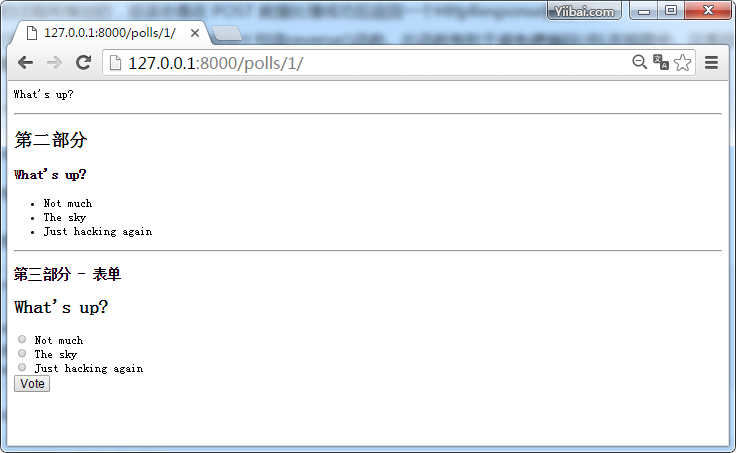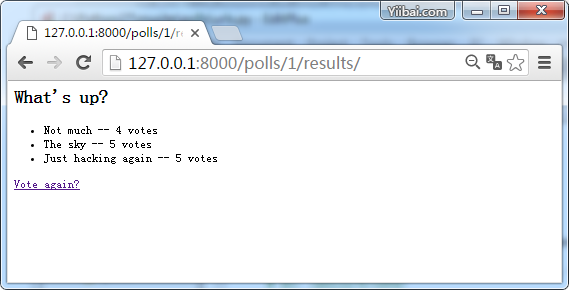Django快速入門-表單
編寫一個簡單的表單
<h1>{{ question.question_text }}</h1>
{% if error_message %}<p><strong>{{ error_message }}</strong></p>{% endif %}
<form action="{% url 'polls:vote' question.id %}" method="post">
{% csrf_token %}
{% for choice in question.choice_set.all %}
<input type="radio" name="choice" id="choice{{ forloop.counter }}" value="{{ choice.id }}" />
<label for="choice{{ forloop.counter }}">{{ choice.choice_text }}</label><br />
{% endfor %}
<input type="submit" value="Vote" />
</form>
簡要介紹:
- 上面的模板顯示每個問題選擇一個無線電鈕。每個無線電鈕的值相聯問題的選擇編號。每個無線電鈕的名稱是「choice」。這意味著,當有人選擇了其中一個無線電鈕並提交表單,它會傳送POST資料choice=#,其中#是被選擇的選擇的ID。這是HTML表單的基本概念。
- 我們設定表單的動作 {% url 'polls:vote' question.id %}, 以及設定 method="post". 使用 method="post" (相對於 method="get") 是非常重要的,因為提交此表將改變伺服器端資料的行為。當建立一個改變資料伺服器端表單形式,使用 method="post". 這篇文章並不是只針對 Django; 這是一個很好的 Web 開發實踐。
- forloop.counter表示表單標籤通過多少次迴圈了
- 因為我們正在建立一個POST形式(可以有修改資料的影響),我們需要擔心跨站點請求偽造。但是也不必擔心,因為Django自帶了保護對抗的一個非常容易使用的系統。總之,這是針對內部URL所有的POST形式應該使用{%csrf_token%}模板標籤。
現在,讓我們建立一個處理提交的資料的一個 Django 檢視。
url(r'^(?P<question_id>[0-9]+)/vote/$', views.vote, name='vote'),
我們還建立了一個虛擬實現 vote() 函式。現在建立一個實用的版本。新增到以下程式碼到檔案 polls/views.py:
from django.shortcuts import get_object_or_404, render
from django.http import HttpResponseRedirect, HttpResponse
from django.core.urlresolvers import reverse
from .models import Choice, Question
# ...
def vote(request, question_id):
question = get_object_or_404(Question, pk=question_id)
try:
selected_choice = question.choice_set.get(pk=request.POST['choice'])
except (KeyError, Choice.DoesNotExist):
# Redisplay the question voting form.
return render(request, 'polls/detail.html', {
'question': question,
'error_message': "You didn't select a choice.",
})
else:
selected_choice.votes += 1
selected_choice.save()
# Always return an HttpResponseRedirect after successfully dealing
# with POST data. This prevents data from being posted twice if a
# user hits the Back button.
return HttpResponseRedirect(reverse('polls:results', args=(question.id,)))
此程式碼包含還沒有在本教學中涉及幾個東西:
-
request.POST是一個類似於字典的物件,使您可以通過鍵名存取提交的資料。在這種情況下,request.POST['choice'] 返回被選擇的choice的ID,作為字串。 request.POST的值總是字串。
注意:Django還提供 request.GET 以相同的方式存取 GET資料 – 但我們明確使用 request.POST 在我們的程式碼,以確保資料只能通過POST呼叫修改。
-
如果POST資料未提供choice,request.POST['choice']將引發KeyError異常。上面的程式碼檢查KeyError異常和錯誤訊息顯示問題的表單,如果沒有給出 choice。
-
選擇choice計數遞增後,程式碼返回 HttpResponse 重定向,而不是一個正常的 HttpResponse。HttpResponseRedirect 需要一個引數:使用者將被重定向到URL(請參閱下面-我們如何構建在這種情況下的URL)。
如上Python的註釋所指出的,應該總是在 POST 資料處理成功後返回一個HttpResponse重定向。
-
在本例中我們使用的是 HttpResponseRedirect 構造reverse()函式。此函式有助於避免寫死URL在檢視中。這是因為我們想通過控制並指向該檢視的URL模式的可變部分的檢視的名稱。在這種情況下,使用 URLconf 組態使 reverse()呼叫返回字串如:
'/polls/3/results/'
其中3是question.id的值。然後,這個重定向的URL將呼叫「results」檢視中顯示的最後一頁。
現在存取網址:http://127.0.0.1:8000/polls/1/ 得到結果如下所示:

當有人在一個問題投票後,vote() 檢視重定向到該問題的結果頁面。讓我們編寫這個檢視(polls/views.py):
from django.shortcuts import get_object_or_404, render
def results(request, question_id):
question = get_object_or_404(Question, pk=question_id)
return render(request, 'polls/results.html', {'question': question})
現在,建立一個 polls/results.html (polls/templates/polls/results.html)模板:
<h2>{{ question.question_text }}</h2>
<ul>
{% for choice in question.choice_set.all %}
<li>{{ choice.choice_text }} -- {{ choice.votes }} vote{{ choice.votes|pluralize }}</li>
{% endfor %}
</ul>
<a href="{% url 'polls:detail' question.id %}">Vote again?</a>
現在,在瀏覽器中開啟 /polls/1/ 並表決的問題。應該會被每次投票時看到更新結果頁。如果您提交表單不選擇一個選項,應該看到錯誤訊息。
選擇選項,提交後顯示如下結果:

使用通用檢視:更少的程式碼更好
修改URL組態
首先,開啟 polls/urls.py 並修改如下:
from django.conf.urls import url
from . import views
app_name = 'polls'
urlpatterns = [
url(r'^$', views.IndexView.as_view(), name='index'),
url(r'^(?P<pk>[0-9]+)/$', views.DetailView.as_view(), name='detail'),
url(r'^(?P<pk>[0-9]+)/results/$', views.ResultsView.as_view(), name='results'),
url(r'^(?P<question_id>[0-9]+)/vote/$', views.vote, name='vote'),
]
請注意,第二和第三模式的正規表示式匹配的模式名稱已經從<question_id>改變為<to>。
修改檢視
接下來,我們要刪除舊的 index, detail, 和 results 檢視使用Django通用檢視代替。要做到這一點,開啟 polls/views.py 檔案並修改它如下:
from django.shortcuts import get_object_or_404, render
from django.http import HttpResponseRedirect
from django.core.urlresolvers import reverse
from django.views import generic
from .models import Choice, Question
class IndexView(generic.ListView):
template_name = 'polls/index.html'
context_object_name = 'latest_question_list'
def get_queryset(self):
"""Return the last five published questions."""
return Question.objects.order_by('-pub_date')[:5]
class DetailView(generic.DetailView):
model = Question
template_name = 'polls/detail.html'
class ResultsView(generic.DetailView):
model = Question
template_name = 'polls/results.html'
def vote(request, question_id):
... # same as above
剩下的你自己發揮了,包教不包會,請參考:https://docs.djangoproject.com/en/1.9/intro/tutorial04/